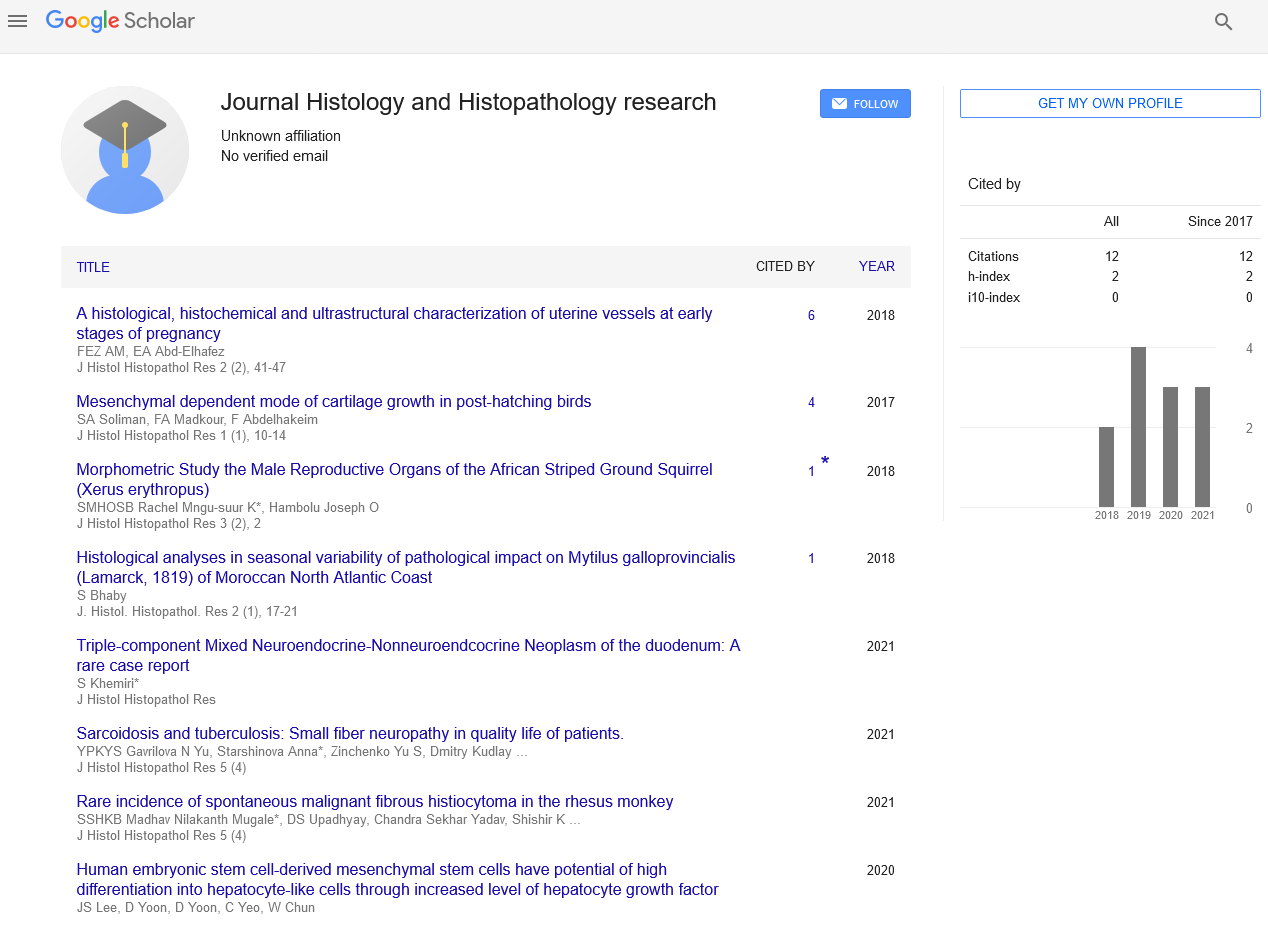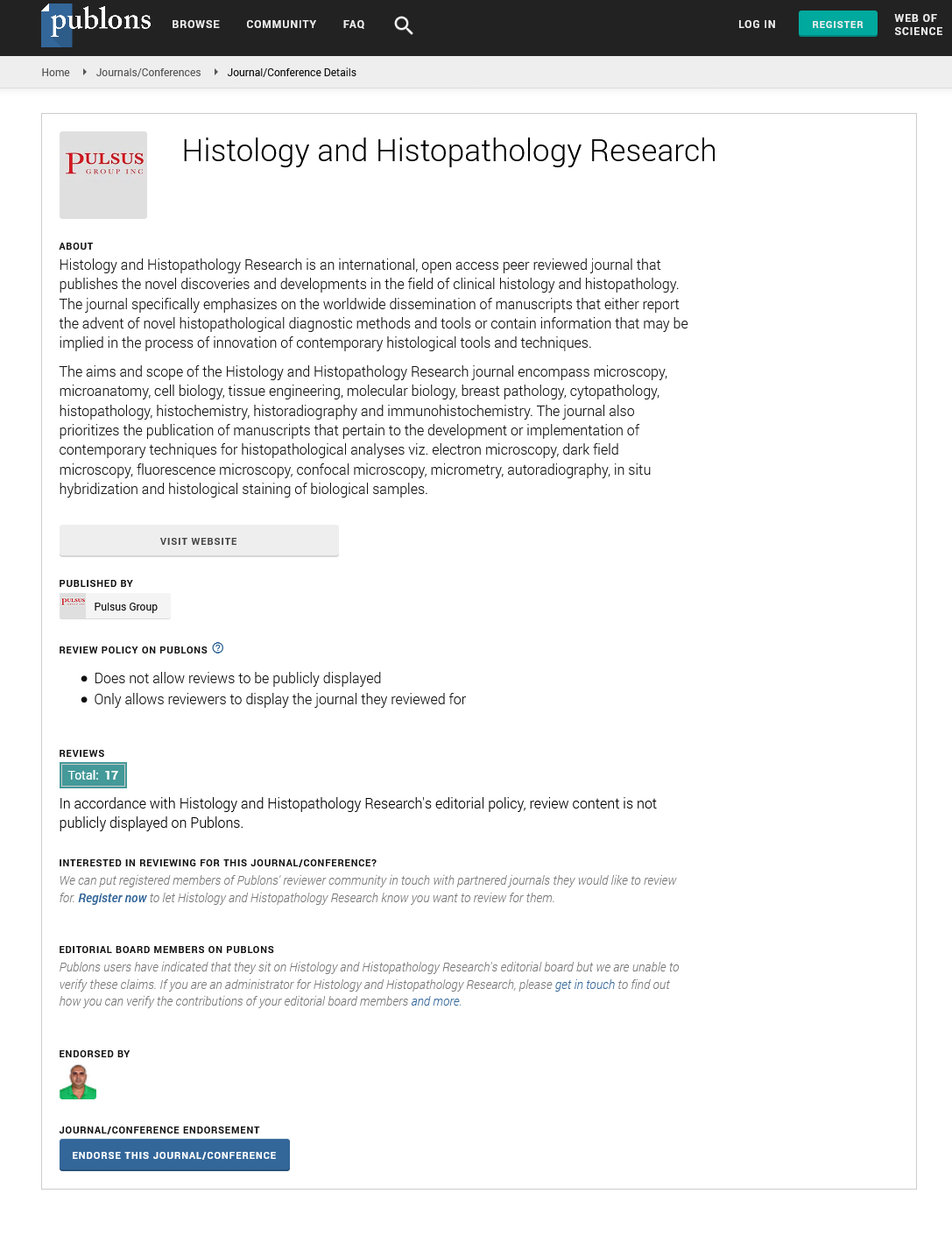Eosinophils have a major role in necrosis, particularly in single-system Langerhans cell histiocytosis.
Received: 02-May-2022, Manuscript No. PULHHR-22-5090; Editor assigned: 04-May-2022, Pre QC No. PULHHR-22-5090 (PQ); Accepted Date: May 21, 2022; Reviewed: 15-May-2022 QC No. PULHHR-22-5090 (Q); Revised: 20-May-2022, Manuscript No. PULHHR-22-5090 (R); Published: 27-May-2022, DOI: 10.37532/ pulhhr.22.6(3).70-71
Citation: Won S. Eosinophils have a major role in necrosis, particularly in single-system langerhans cell histiocytosis. J Histol Histopathol Res. 2022;6(3):70-71.
This open-access article is distributed under the terms of the Creative Commons Attribution Non-Commercial License (CC BY-NC) (http://creativecommons.org/licenses/by-nc/4.0/), which permits reuse, distribution and reproduction of the article, provided that the original work is properly cited and the reuse is restricted to noncommercial purposes. For commercial reuse, contact reprints@pulsus.com
Abstract
Single-system Langerhans Cell Histiocytosis (LCH) exhibits extensive eosinophil infiltration as well as occasional necrosis and cyst/cavity development; however the origin of the necrosis is unknown. Because the involvement of eosinophils in necrosis in single-system LCH has not been studied previously, we evaluated it pathologically.
Due to the proliferation of histiocyte-like cells, which have recently been proven to be Langerhans cells, Langerhans Cell Histiocytosis (LCH) incorporates eosinophilic granuloma, Hand-Schüller-Christian illness, and Letterer-Siwe disease. The BRAF V600E mutation is a significant genetic component in LCH, and a new name (inflammatory myeloid neoplasia) was coined.
Keywords
Langerhans Cell Histiocytosis; Necrosis; Langerhans cells
LANGERHANS CELL HISTIOCYTOSIS
Single-system Langerhans Cell Histiocytosis (LCH) exhibits extensive eosinophil infiltration as well as occasional necrosis and cyst/cavity development; however, the origin of the necrosis is unknown. Because the involvement of eosinophils in necrosis in single-system LCH has not been studied previously, we evaluated it pathologically.
Due to the proliferation of histiocyte-like cells, which have recently been proven to be Langerhans cells, Langerhans Cell Histiocytosis (LCH) incorporates eosinophilic granuloma, HandSchüller-Christian illness, and Letterer-Siwe disease. The BRAF V600E mutation is a significant genetic component in LCH, and a new name (inflammatory myeloid neoplasia) was coined.
Histologically, nodular-shaped, single-system LCH is mostly composed of Langerhans cells and eosinophils, thus the term eosinophilic granuloma. According to serial computed tomography scans, radiographic pulmonary LCH evolves from nodules to cavitated nodules and finally to thick-walled cysts. Intralesional cytokines generated by Langerhans cells and T cells are considered to have a role in necrosis, particularly in bone and other organs, but the reason for this necrosis, which is followed by a destructive process, is unknown, as is the involvement of eosinophils. From a pathologic standpoint, we endeavoured and succeeded in revealing the connection of necrosis in LCH with eosinophilic degranulation. From the beginning of 1998 to the end of 2011, biopsy/lobectomy specimens were obtained in 49 instances meeting the pathological criteria of LCH from 22 hospitals. Organs were obtained from 33 lungs and 17 other organs. There were 47 cases of single-system LCH and 2 cases of multiple-system LCH without the participation of "Risk Organs." The association between eosinophils and necrosis, as well as distinct types of tissue degradation and subsequent discoveries, were studied. Cellular characteristics of the first LCH lesion were also thoroughly studied. Anti-eosinophilic antibodies were utilised in routine histopathological and immunohistochemical studies. The following were the destructive characteristics and subsequent findings of pulmonary LCH from 30 cases: vascular destruction, cyst/cavity forms, 22; filling of tissue defect and elastic tissue, 30; and reticuline fibre destruction. In two cases, there were few necroses associated with the degranulation of dead eosinophils but no fibrosis. In the cellular-stage lesions, there were a lot of Langerhans cells and eosinophils, and they were all together. The following were the destructive characteristics and subsequent discoveries of non-pulmonary LCH from 17 cases: coagulative necrosis to varying degrees without fibrosis, cavity development and cell shedding, and reticuline fibre network disruption. Most necrotic lesions had a large number of dead eosinophils following degranulation, as well as a few Charcot-Leyden crystals. Neutrophil degranulation in necrotic lesions was restricted to living cells.
we confirmed in this study that
• Pulmonary LCH showed a destructive process, including cyst/cavity formation and the destruction of arteries, elastic and reticuline fibre networks
• Non-pulmonary LCH showed necrosis and a destructive process, including cavity formation and reticuline fibre network destruction
• Dead eosinophils with degranulation were present to a significant degree in non-fibrotic, necrotic areas, particularly in non-pulmonary LCH
• We focused on necrosis and cavity development and discovered that the frequency and degree of necrosis differed markedly between the lung and other organs, and we attempted to create a coherent explanation for this disparity.
LCH of bone is distinguished by the loss of skeletal trabeculae, eosinophil infiltration, and often localised but occasionally widespread coagulation necrosis. There was discussion of eosinophil degranulation (with the production of three cationic proteins) and subsequent protein absorption in macrophages, but no mention of tissue necrosis. The LCH of lymph nodes exhibits varying degrees and frequency of necrosis. In three of the 18 cases of coagulation necrosis, Charcot-Leyden crystals were seen. Overall, coagulation necrosis and eosinophilic abscess were common in LCH of bone and lymph nodes. Based on the presence of degranulated, dead eosinophils and some Charcot-Leyden crystals remaining in the necrotic area, we hypothesised that a) the earliest cellular lesion begins with Langerhans cell proliferation and eosinophil infiltration, and b) by an unknown stimulus, eosinophilic degranulation in the cellular stage without fibrosis causes tissue necrosis.
Because most of the cellular stages lesions retained a limited number of neutrophils, massive infiltration of neutrophils with degranulation might represent a subsequent occurrence following necrosis.Meanwhile, it was revealed that in 21% of instances, the number of neutrophils matched or surpassed the number of eosinophils. In the current investigation, neutrophils were detected using enzyme activity (elastase), and neutrophil degranulation was confined to living cells. This approach detects no enzyme activity when neutrophils die. Because there were no dead eosinophils in one region of necrosis, it is probable that neutrophilic degranulation induced coagulation necrosis, followed by neutrophil death and the full cessation of enzyme activity. However, at this time, we were unable to confirm the function of neutrophils in necrosis.
Patients with single-system LCH involvement in one organ have a favourable prognosis. When patients have a protracted course, suppressing eosinophilic activity, such as quitting smoking, may be an option in single-system LCH, including non-pulmonary LCH, because smoking stimulates eosinophils in the same way as it does in acute eosinophilic pneumonia.
The retroactive methodology of this investigation limited our ability to stain cytokines to generate and activate eosinophils and neutrophils in LCH. In addition, we were unable to investigate the involvement of Langerhans cells, T helper cells, and macrophages in tissue injury and necrosis.
The current findings show a link between the prior degranulation of dead eosinophils in necrosis and different types of tissue damage in both non-pulmonary and pulmonary LCH. The next critical step in the regulation of single-system LCH is more research to avoid necrosis.






